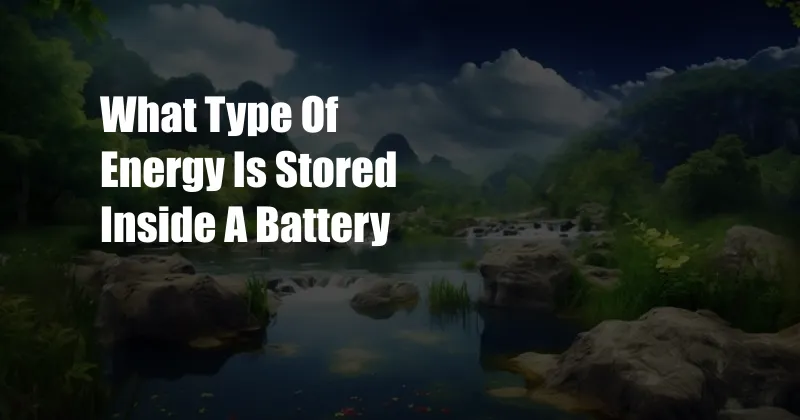
What Type of Energy Is Stored Inside a Battery?
Imagine yourself on a road trip, cruising along the highway, when suddenly your car’s engine sputters and dies. Panic sets in as you realize you’re stranded in the middle of nowhere, with no cell phone service and a rapidly dwindling battery. In that moment, you may wonder, what exactly is this energy that’s keeping my car running? The answer lies in the battery, a device capable of storing and releasing electrical energy.
Batteries have become an integral part of our lives, powering everything from our smartphones to electric vehicles. But what exactly is the energy stored within these devices? In this comprehensive guide, we will delve into the different types of energy stored in batteries, exploring their history, mechanisms, and the latest advancements in battery technology.
The Electrochemistry of Batteries
Definition and History
A battery, in its simplest form, is an electrochemical cell that converts chemical energy into electrical energy. The first batteries were invented by Alessandro Volta in 1800 and revolutionized the field of electricity. These early batteries, known as “Voltaic piles,” consisted of alternating layers of zinc and copper, separated by brine-soaked cardboard. When connected to a circuit, the chemical reaction between the metals and the electrolyte produced an electric current.
Meaning and Significance
Batteries play a crucial role in modern society, providing portable and reliable sources of power. They enable us to use our electronic devices on the go, power our homes and businesses, and even propel electric vehicles. The development of advanced battery technologies is essential for the transition to renewable energy sources and the reduction of our carbon footprint.
Types of Energy Stored in Batteries
Batteries store energy through various mechanisms, primarily involving electrochemical reactions. The two main types of energy stored in batteries are:
- Chemical Energy: The primary form of energy stored in batteries is chemical energy. This energy is present in the chemical bonds of the materials used in the battery, such as the anode and cathode. During discharge, the chemical bonds break, releasing electrons and creating an electric current.
- Electrical Energy: Once the chemical reactions begin, batteries produce an electric current. This current flows through the circuit connected to the battery, powering devices or charging other batteries. The electrical energy stored in a battery is measured in watt-hours (Wh) or ampere-hours (Ah).
Factors Affecting Battery Performance
The performance of a battery depends on several factors, including:
- Materials Used: The materials used in the anode, cathode, and electrolyte determine the battery’s capacity, voltage, and lifespan.
- Battery Design: The physical design of the battery, such as its size, shape, and electrode configuration, affects its performance and efficiency.
- Charge-Discharge Cycles: The number of times a battery can be charged and discharged significantly impacts its lifespan.
- Temperature: Batteries operate within a specific temperature range. Extreme temperatures can affect their performance and shorten their lifespan.
Latest Trends and Developments in Battery Technology
The field of battery technology is constantly evolving, driven by the demand for higher capacity, longer-lasting batteries. Some notable advancements include:
- Lithium-Ion Batteries: These are the most popular type of batteries used in portable devices today. They offer high energy density, long lifespan, and relatively low self-discharge rate.
- Solid-State Batteries: These batteries use solid electrolytes instead of liquid ones, making them more stable and potentially safer.
- Flow Batteries: These batteries store energy in liquid electrolytes, allowing for large-scale storage and discharge cycles.
Tips for Maximizing Battery Life
To extend the life of your batteries, follow these expert tips:
- Avoid Overcharging: Fully charging your batteries can reduce their lifespan. Unplug them once they reach 100% charge.
- Calibrate Your Batteries: Regularly discharge your batteries completely, then fully charge them. This helps maintain their accuracy in measuring remaining charge.
- Store Batteries Properly: Store batteries in a cool, dry place. Extreme temperatures can damage them.
- Use the Right Charger: Use a charger designed specifically for your battery type. Improper charging can damage the battery.
By following these tips, you can maximize the performance and lifespan of your batteries. Remember, batteries are a valuable resource that should be used responsibly.
FAQ on Battery Energy
Here are some frequently asked questions and their answers on the topic of battery energy:
- What is the difference between a primary battery and a secondary battery?
Primary batteries are designed for single-use only, while secondary batteries can be recharged multiple times. - What is the most common type of battery used today?
Lithium-ion batteries are the most widely used type of battery today due to their high energy density and long lifespan. - How can I safely dispose of batteries?
Never throw batteries in the trash. Dispose of them properly at designated recycling centers or collection points.
Conclusion
Batteries have revolutionized our modern world, providing us with portable and reliable sources of power. Understanding the different types of energy stored in batteries, their performance factors, and the latest advancements in battery technology is essential for utilizing these devices effectively and responsibly.
Whether you’re a tech enthusiast, a sustainability advocate, or simply someone who relies heavily on electronic devices, it’s important to be informed about the energy stored within batteries. By making conscious choices and following expert advice, we can prolong the lifespan of our batteries and minimize their environmental impact.
Are you interested in learning more about battery technology and its applications? If so, subscribe to our blog for the latest updates and insights on this fascinating topic.